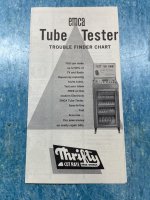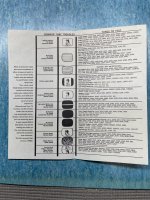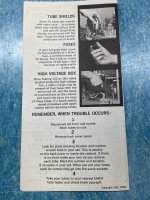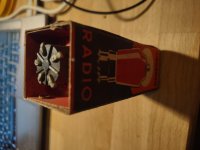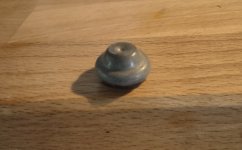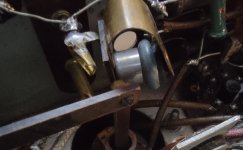It’s a common rumor that all tubes tested bad so they could sell more.
Then what happened if you tested the new tubes before buying them? Most of your old tubes
would usually test ok, as I recall.
I remember my dad fixing the TV by looking to see which valve wasn't lit.
One of those old square box TVs with a chassis in the base.
B&W, 405 lines, VHF.
Replaced in 1972 with a colour TV that could receive the new 3rd channel, UHF & 625 lines!
One of those old square box TVs with a chassis in the base.
B&W, 405 lines, VHF.
Replaced in 1972 with a colour TV that could receive the new 3rd channel, UHF & 625 lines!
I recall those...they had an Instruction manual tied to the side with string...But my knowledge of tubes came along about the same time as tubes were going obsolete & the devices disappeared before I learned of the technology.
My first foray into tubes was troubleshooting my folks 'modern wooden' 70s RCA tube TV...the same set that we were circled around when Nixon resigned, and myself in a state of profound maturity declared, "this is history!".
Poking around, I found the "suction-cup" anode connection burned apart...fixing that...we had no color, referring to the comprehensive schematic pasted on the insides...a 12AX7 color amp tube...finding another 12AX7 for synch ..I swapped em' ...color was back, but the synch was lost, weird, a collection of frames floating about to & fro ..."Found it!"....it needs a new tube, one of these".
------------------------------------------------------------------------Rick...
My first foray into tubes was troubleshooting my folks 'modern wooden' 70s RCA tube TV...the same set that we were circled around when Nixon resigned, and myself in a state of profound maturity declared, "this is history!".
Poking around, I found the "suction-cup" anode connection burned apart...fixing that...we had no color, referring to the comprehensive schematic pasted on the insides...a 12AX7 color amp tube...finding another 12AX7 for synch ..I swapped em' ...color was back, but the synch was lost, weird, a collection of frames floating about to & fro ..."Found it!"....it needs a new tube, one of these".
------------------------------------------------------------------------Rick...
When I was little (late 50's/early 60's) 7-11 had a singing jingle advertising their in-house tube testers -
"The murder victim breathes her last, the case is hard to crack,
the cops are picking up the trail, but the TV set goes black -
Come on and test your TV tubes, absolutely free, at your 7-11 store, close to you and me..."
There were a couple more verses, but you get the idea.
"The murder victim breathes her last, the case is hard to crack,
the cops are picking up the trail, but the TV set goes black -
Come on and test your TV tubes, absolutely free, at your 7-11 store, close to you and me..."
There were a couple more verses, but you get the idea.
A (late) uncle of mine used to be a jukebox repairman in New Zealand. He didn't know anything about electronics, but if the problem wasn't mechanical, he just swapped valves until it worked again.
My first time at the tube tester started with"Hey kid leave that alone". I was little but had a pocket full of tubes to test. Same guy who tried to shoo me away helped me test the tubes and find the bad one. bought a new one and was able to get the old tv in the basement working again, but everyone else knew it didn't work so I wiggled one tube until it went out and no one was the wiser. With a big family and only one TV conflicts arose, so I would sneak downstairs push the loose tube in and watch what I wanted. Finally got caught and had to admit I fixed it.
It’s a common rumor that all tubes tested bad so they could sell more.
Rumor, yes.
But the fact is, those "rigged" testers were out there.
I know, because one place near me, Penn Electronics, had one of those hidden switches behind the counter.
Since I worked part time there, I asked the owner what it was, and he said if someone came in to test tubes, hit the switch while watching the customer test his tubes.
The owner also told me that it was rigged by a guy who traveled and made a living off of adding in that secret switch.
It’s a common rumor that all tubes tested bad so they could sell more.
Then what happened if you tested the new tubes before buying them? Most of your old tubes
would usually test ok, as I recall.
Back in those days, people didn't test newly purchased tubes, they were in a box, once you open it, you bought it.
One more thing about tube tv's and radios.....
Yes, tubes were in sockets, and yes could be tested......... but....
If a tube failed, it was likely because of some "under the chassis" problem.
So while replacing the tube might "fix it" for a while..... the tube would eventually fail again.
Some sets ran their tubes at the edge of their limits - boosting power, but shortening their life.
It helped marketing, spec-wise, and also tube sales.
Yes, tubes were in sockets, and yes could be tested......... but....
If a tube failed, it was likely because of some "under the chassis" problem.
So while replacing the tube might "fix it" for a while..... the tube would eventually fail again.
Some sets ran their tubes at the edge of their limits - boosting power, but shortening their life.
It helped marketing, spec-wise, and also tube sales.
Back in those days, people didn't test newly purchased tubes, they were in a box, once you open it, you bought it.
The tubes from the earlier days had the pins exposed so they could be tested without breaking the seal on the box.
Attachments
So who remembers taking the accumulator from their radio to get recharged? Oddly in the 40s in UK it was a job given to kids despite them being a combination of glass and acid!
Depends on the decade I believe. The heaters used to use 2V lead acid cells and were referred to as accumulators. They needed charging every week. The HT battery wasn't usually rechargable (happy to be corrected on that).
My mum was left an old radiogram in a will in the early 1960's.
It came with a ton of 78RPM records.
The radio worked Europe wide with lots of foreign place names on the dial.
It had a magic eye for accurate tuning.
A Look At A NOS 6E5 Magic Eye Tube - YouTube
It came with a ton of 78RPM records.
The radio worked Europe wide with lots of foreign place names on the dial.
It had a magic eye for accurate tuning.
A Look At A NOS 6E5 Magic Eye Tube - YouTube
Last edited:
If I remember correct most valve radio's had 2 batteries.
90 volt for B+ and 6V for heaters.
I'll toss in another oddity.......
In some radios, the detector/first audio tube had a small wired-in battery, 1 or 2 volts, that kept the cathode above ground.
I forget the make/models, but likely around 1930's era.
Hi, A Tucson AZ electronic parts house (Elliotts) has one of these set up for customer use. I have my own tester so I don't use theirs, but I have seen folks use it. They used to be everywhere.
.... detector/first audio tube had a small wired-in battery, 1 or 2 volts, that kept the cathode above ground....
In Philly: almost certainly in the grid circuit. No current, cell lasted for decades. (In Germany, sometimes NiCad were put in the cathode.)
The tubes from the earlier days had the pins exposed so they could be tested without breaking the seal on the box.
NEVER seen that in the US. Tube boxes were highly standardized. I don't even remember them having a seal. But I do remember you could not get a new tube from the drawer yourself, you asked the clerk to unlock it and pluck a tube. (But maybe this was only when they saw me coming?)
Here is one I reviatalised recently by replacing the innards with an LR8 button cell.
It was funny going to the electrical shop and asking for a button cell for my 1936 radio ;-)
It was funny going to the electrical shop and asking for a button cell for my 1936 radio ;-)
Attachments
- Home
- Amplifiers
- Tubes / Valves
- Who remembers...
